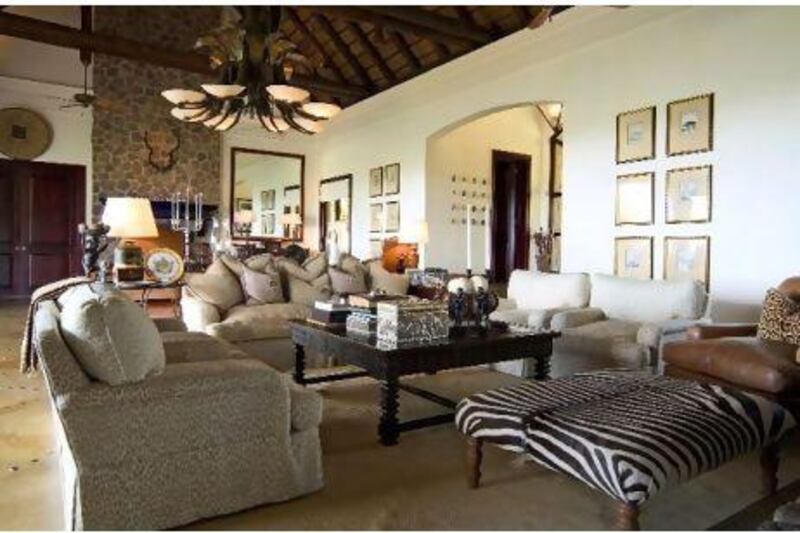Trisha Wilson has designed some of the most iconic interiors in the UAE - from the Park Hyatts in Dubai and Abu Dhabi to the original One & Only Royal Mirage, Atlantis The Palm and, whisper it, the Armani Hotel Dubai. Wilson Associates, the firm that she founded in Dallas, Texas, in 1971, has put its stamp on more than one million hotel rooms around the world, not to mention residential, retail, spa and restaurant projects, and its client list includes 20 of the world's top 100 billionaires. But when it comes to her own personal spaces, Wilson takes a lower key approach.
Although she is still based in Dallas, she spends a portion of the year in her own game lodge in the Waterberg Mountains of Limpopo Province, South Africa. The lodge, which is called Izingwe, the zulu word for leopard, is set on a 100,000-acre site in the Welgevonden Private Game Reserve, and is home to the "big five" - lions, leopards, elephants, buffaloes and rhinos - as well as countless other types of flora and fauna. "It's a place where the quiet is interrupted by the roar of a lion or the bark of a baboon," she says. "My visits to Izingwe refresh, rejuvenate and inspire my soul."
Warm and comfortable, the interiors of the lodge are straight out of colonial Africa. Local materials, stone plinths, natural gum poles, sand-coloured hand-plastered walls and thatched roofs set the tone. Furniture is heavy and imposing, from the dark wood coffee table to the grand four-poster bed. Carved into the top of each of the wooden bedposts is a bird of prey that looks as if it is watching over the sleeper.
Browns and beiges dominate, interspersed with animal print motifs. The main seating area is dominated by a mish-mash of options - a sumptuous beige sofa disappearing under a deluge of cushions, a worn brown leather chair, oversized sofa seats with an understated leopard print motif, and a zebra skin footstool. There are candlesticks, knick-knacks and photo frames everywhere. Everything feels a little bit worn, but is bursting with character.
The animal theme is strong - an ever-present reminder of the lodge's geographical context. There are baboons on cushions, antlers on walls, bird-shaped bowls, rhino statues and ostrich eggs. The space is an unashamed celebration of its environment.
"The bush gives me balance and boundaries, and speaks to my soul. My game lodge is a celebration of the beauty of the natural surroundings," says Wilson, who started her career selling mattresses in a department store. "For me, home is a comfortable space where my collections of art, artefacts and treasures are showcased.
"I have an assortment of three-inch multicoloured passport masks in my main lodge. I matted each mask on plexi-glass and displayed them in a straight pattern. The natives saw that the Westerners had pictures of themselves on their passports, so they carved their own square likenesses. They are decorative, yet spark an interesting conversation." If Wilson has one regret, it is that she does not have enough time to add to her collections. "It's important to focus on something you love and collect it. I personally love zulu telephone wire baskets, and have collected pieces with meaningful words. In our projects we have installed collections of photographs, maps, shells or even antlers."
Also evident in the lodge is Wilson's appreciation of feng shui, which she says is a sure-fire way to improve a space. "Zen design is a [path] to enlightenment and can lead the way to a balanced and harmonious environment. The subtle combination of the five elements - wood, fire, earth, metal and water - by way of colour, shape and materials will introduce symmetry when installed into a space."
There is certainly a sense of harmony on the grounds of Izingwe, from the sumptuous interiors to the stunning outdoor areas. Here, oversized daybeds offer an invitation to linger, while an intimate infinity pool looks over the reserve, offering plenty of opportunity for reflection.
While Izingwe was initially designed as a private retreat, Wilson recently decided to open it up to the public, so they too could "experience the wild beauty" that she has spent years enjoying. "Also, I feel a humanitarian obligation to support the children and families of Limpopo Province, so I've decided to donate a portion of each guest's stay to The Wilson Foundation's programmes," she explains. "My work has taken me around the globe to some of the most exotic locations, and I truly believe travel can impact social change."
Wilson founded The Wilson Foundation in 1997 to address the needs of disadvantaged children, particularly in the rural Limpopo Province, an area devastated by extreme poverty, unemployment, substandard education and an HIV pandemic that has left thousands of children orphaned. To date, the foundation has generated an incredible US$3.5 million (Dh12.9m).
It is clear that Izingwe is the first tentative step on the road to a bigger goal - the perfect marriage of Wilson's two great loves, design and humanitarianism. It is telling that her favourite book is Nelson Mandela's autobiography Long Walk to Freedom and that she counts Quincy Jones among her friends.
"My dream project would be to design a hotel in the middle of the South African bush," she reveals. "The hotel would not be a camp, but a destination. My vision would change the face of hospitality in the wild forever.
"I'd imagine it to be a Robinson Crusoe meets jungle treehouse dream world. A portion of each guest's stay would go back to the rural community in South Africa that The Wilson Foundation supports.
"Overall, the space would perfectly combine my two greatest passions: the wilderness of the bush and the beauty and comfort that starts with great architecture."






